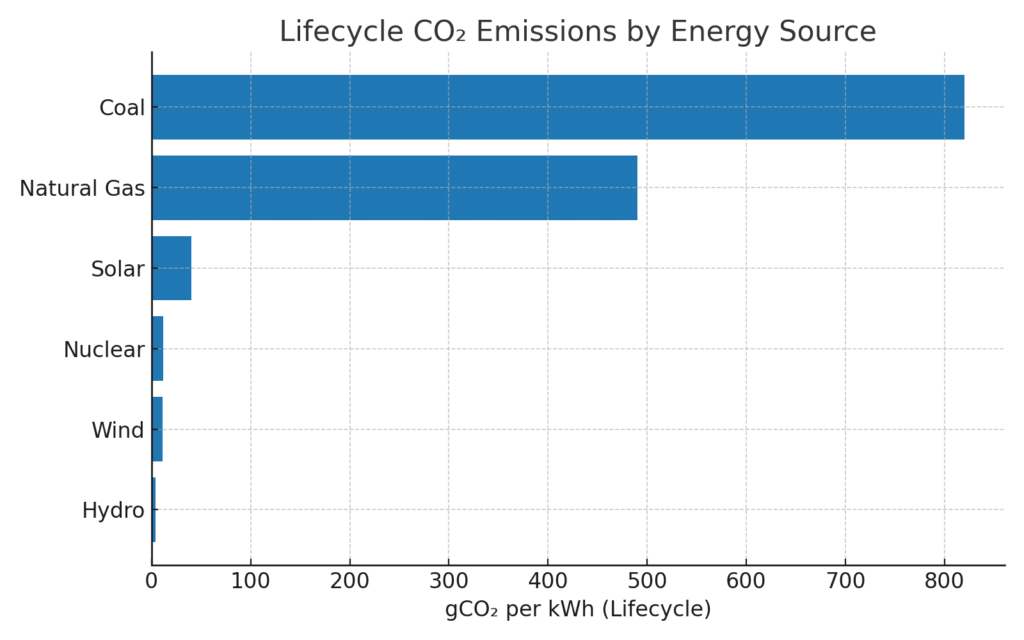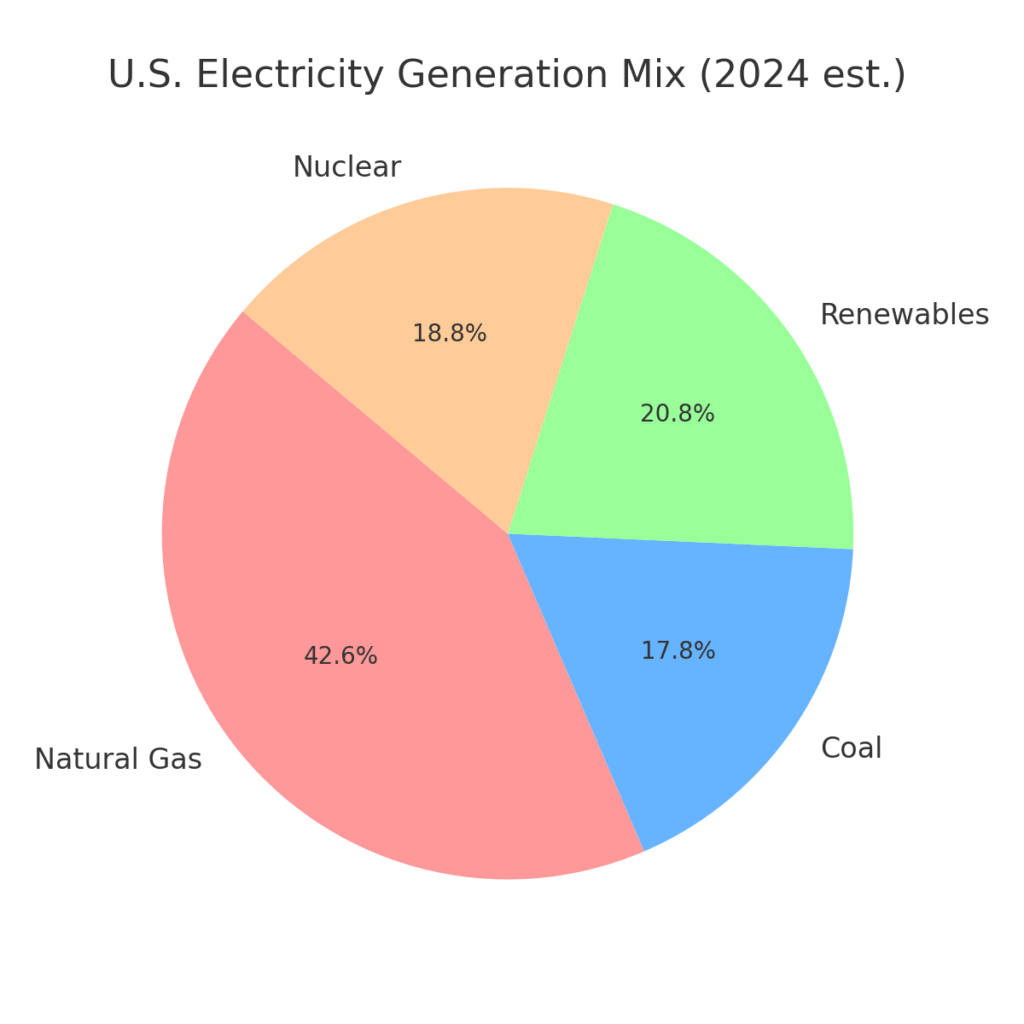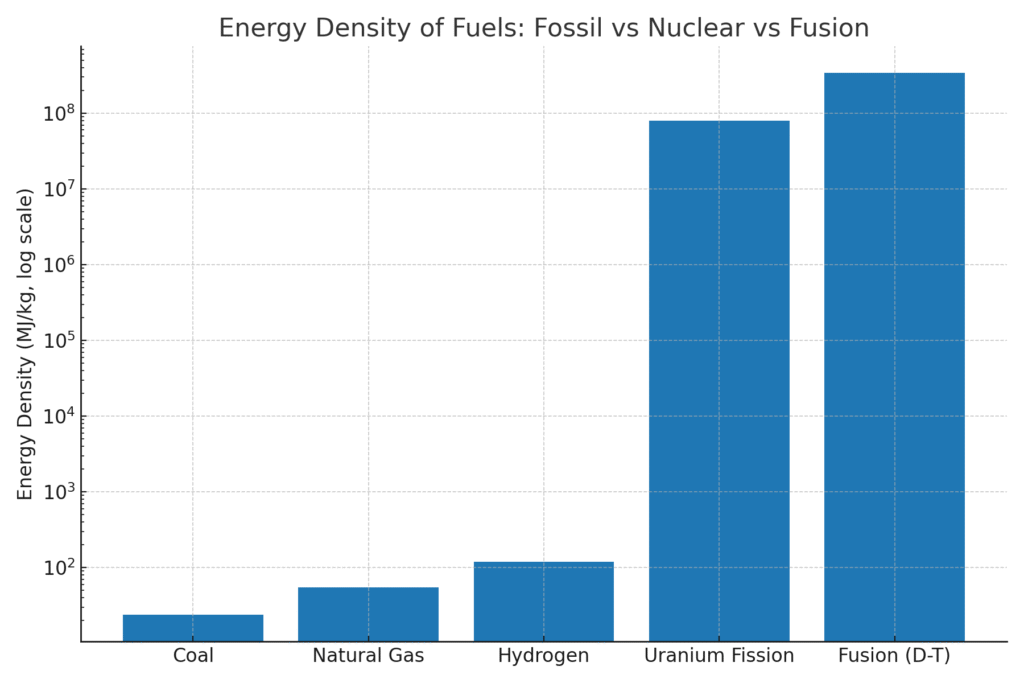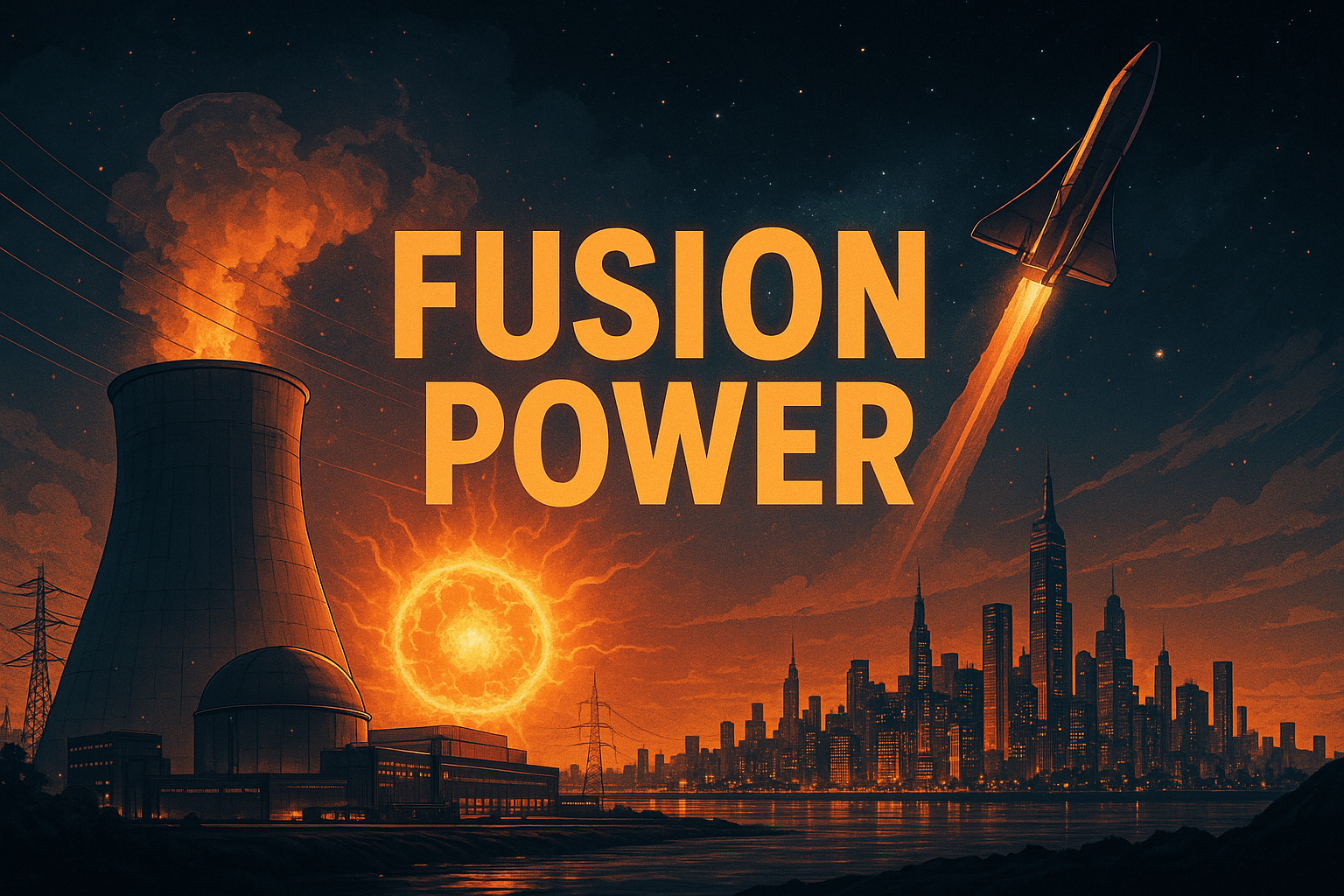Why Nuclear Energy Still Matters
Nuclear power remains one of the most effective tools for generating low-carbon energy. Across its lifecycle, nuclear produces just about 12 grams of CO₂ per kilowatt-hour, placing it among the cleanest energy sources alongside wind and hydropower [2]. Since 1970, nuclear reactors worldwide have prevented an estimated 72 billion tonnes of CO₂ emissions [2].
In the United States, nuclear produces nearly 800 billion kilowatt hours annually—over half of the country’s carbon-free electricity. That contribution avoids more than 470 million metric tons of carbon emissions each year, the equivalent of removing 100 million cars from the roads [1].
Beyond carbon, nuclear provides what many renewables cannot: continuous, base-load power. Where wind and solar fluctuate, nuclear runs day and night, anchoring grid stability [2].

Economically, the sector is vital. In the U.S. alone, nuclear supports almost half a million jobs, with salaries about 30% higher than local averages [3]. These roles—from engineers to skilled trades—generate billions in tax revenues that sustain communities [4].

The Promise of Localized Mini-Nuclear Plants (SMRs)
The traditional model of large, centralized power stations is increasingly misaligned with a world that values resilience and decentralization. Enter Small Modular Reactors (SMRs): compact, factory-built nuclear plants designed for scalable deployment.
SMRs can be installed closer to where electricity is consumed, reducing the need for long transmission lines and lowering vulnerability to widespread outages [5]. If a mini-plant fails, disruptions are confined to smaller zones rather than entire regions.
Because they can be sited on existing grid locations—such as retired coal plants or mini local hydro grid stations present in nearly every city—SMRs offer a cost-effective bridge to a low-carbon future [7]. These pre-existing sites already have the grid connections, cooling access, and land-use approvals that make retrofits faster and cheaper than greenfield builds.
SMRs can also pair with industrial facilities to provide process heat for steelmaking, chemicals, and cement, or supply desalination plants with both clean water and clean energy. In many coastal regions struggling with water scarcity, SMRs could serve as dual-purpose anchors for entire communities.
The International Atomic Energy Agency emphasizes that SMRs are not just about electricity—they can produce hydrogen, synthetic fuels, and district heat, unlocking new pathways for sustainable urban and industrial growth [7].
Poverty, Energy Access, and Environmental Gains
Nearly 1 billion people worldwide still lack access to electricity [6]. For these communities, reliable energy is not just a climate issue—it is the foundation of economic opportunity, healthcare, and education.
Localized nuclear plants could become a direct replacement for diesel generators that currently power many off-grid communities. In Africa, South Asia, and island nations, SMRs could leapfrog fossil fuels entirely, providing stable, carbon-free power where no modern grid exists.
By reusing existing hydro and coal infrastructure in cities and deploying modular units in rural areas, nuclear becomes not only a tool of decarbonization, but also one of human development and global justice.

Technological Advances and Safety
Public skepticism has long been nuclear energy’s greatest challenge. Safety and waste remain front-of-mind for policymakers and communities alike. Yet today’s reactors are far safer than their predecessors.
The AP1000 design, for example, incorporates passive safety systems that allow a reactor to shut itself down without human intervention or external power [5].
SMRs, thanks to their compact cores and below-ground designs, can be equipped with advanced containment, simplified cooling, and modular redundancy. Many proposed SMRs also use fuel forms that resist meltdown, such as TRISO particles—tiny uranium kernels wrapped in ceramic layers—described by engineers as “walk-away safe.”
New approaches to fuel recycling and closing the fuel cycle are steadily shrinking waste volumes, extending uranium efficiency, and creating a more circular nuclear economy.
The Fusion Horizon: Humanity’s Next Energy Leap
If fission is our present, fusion is our future. By fusing light atoms—typically isotopes of hydrogen—under immense heat and pressure, fusion replicates the process that powers the stars.
The potential is staggering:
- Limitless, clean energy: Fusion reactions produce four million times more energy per kilogram of fuel than coal, with virtually no long-lived waste [8].
- Compact applications: One fusion plant could power an entire metropolis—or portable designs might one day serve individual cities or remote regions.
- Space propulsion: Fusion may fuel interplanetary exploration, making long-duration space travel feasible. While Star Trek popularized antimatter, fusion alone could unlock practical spacecraft engines [8].
- Economic transformation: With abundant, nearly free energy, industries such as hydrogen production, desalination, and carbon capture could expand without constraint.

Already, progress is tangible. In 2022, the U.S. National Ignition Facility achieved fusion ignition—producing more energy from fusion reactions than was used to initiate them [9]. International projects like ITER in France aim to scale these breakthroughs into commercial reactors within the coming decades [9].
Fusion is no longer a question of if, but when. Just as the light bulb was once dismissed as fantasy, humanity may soon harness the power of the stars.
Policy, Investment, and the Path Forward
Realizing nuclear’s full potential requires more than technology. It depends on supportive policy frameworks that reduce financial risk and accelerate construction.
Organizations from the International Energy Agency to the World Economic Forum argue nuclear must be central to any credible net-zero roadmap [2][6]. That means streamlining licensing, modernizing safety codes, and fostering public-private partnerships.
In practice, this means prioritizing SMR retrofits at coal and hydro sites in cities, while simultaneously investing in frontier research to bring fusion from the lab to the grid.
At the same time, governments must commit to long-term fusion funding, ensuring humanity addresses not only today’s climate crisis but also tomorrow’s energy abundance.
Conclusion: A Lecture in Simplicity
To the scientist, the lesson is simple: nuclear remains one of the most dense, reliable, and proven energy sources we possess. To the policymaker, the arithmetic is undeniable: without nuclear—particularly localized SMRs—decarbonization goals cannot be met.
And to the dreamer? Fusion is the beacon on the horizon. From centralized fission giants, to SMRs replacing coal stacks and hydro depots, and eventually to fusion engines that echo the stars, nuclear power is not just a technology—it is a civilizational trajectory.
If humanity dares to push further, we may discover that the energy of the cosmos itself is our true inheritance.
References
- U.S. Department of Energy. Advantages and Challenges of Nuclear Energy. energy.gov
- International Energy Agency. Nuclear Power in a Clean Energy System. iea.org
- U.S. Department of Energy. Nuclear Energy: Supporting Jobs. energy.gov
- Nuclear Energy Institute. Nuclear for the Next Generation. nei.org
- U.S. Department of Energy. 5 Nuclear Energy Stories to Watch in 2023. energy.gov
- World Economic Forum. Nuclear Power: Current Capacity and Expert Perspectives. weforum.org
- International Atomic Energy Agency. What are Small Modular Reactors (SMRs)? iaea.org
- Innovation News Network. How Nuclear Fusion Innovation is Unlocking a Sustainable Energy Future. innovationnewsnetwork.com
- Lawrence Livermore National Laboratory. National Ignition Facility Fusion Breakthroughs. llnl.gov
Future Readings
- Fusion’s Frontier: ITER Project – Building the World’s Largest Tokamak (iter.org)
- SMRs in Transition: World Nuclear Association – Small Nuclear Power Reactors (world-nuclear.org)
- Energy & History: Vaclav Smil – Energy and Civilization: A History (MIT Press, 2017)
- Visionary Futures: Michio Kaku – Physics of the Future (Doubleday, 2011)
- Policy Roadmaps: International Energy Agency – Net Zero by 2050 (iea.org)


